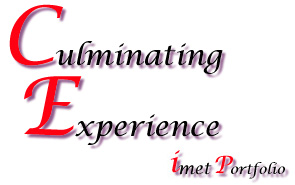

iMET Home | Electronic Portfolios
The schedule below will help iMET students track progress toward the completion of the master's portfolio.
Jumping points:
| Format | Activity |
TI
February 15
|
Rationale Statements and References |
|
Friday, February 16, 2001 5:00 - 5:30 Check-in 5:30 - 6:15 Potluck Dinner 6:15 - 7:15 Portfolios 7:15 Break 7:30 - 8:30 Action Research 8:30 - 9:00 Questions and Circle Saturday, February 17, 2001 9:00 - 9:30 Check-in 9:30 - 12:00 Library Research and Advising
12:00 - 1:00 Lunch 1:00 - 3:30 WebQuests, Library Research and Advising
3:30 - 4:00 Discussion 4:00 Circle
|
|
|
Posting of References |
| TI
February 28 WebQuest
TI March 1 Portfolio |
Reviewing WebQuest progress. Initial drafts or outlines for Review of Literature |
|
Finalizing WebQuests and uploading
|
|
TI
March 14 Action Research
TI March 15 Portfolio |
Action Research: Data Mills: Chapter 3
Mills: Chapter 4
Mills: Chapter 3
Portfolio: First Peer Review
|
|
Portfolio and Action Research
|
|
TI
March 28 Action Research
TI March 29 Portfolio |
Action Research discussions
in Pepperdine #327
Evaluating and Coding Mills: Chapter 5 pages 100-110
|
|
Reporting your findings
|
|
|
Reporting your findings
|
|
| TI April 25
Action Research
TI April 26 Portfolio |
Action Research: Discussion of findings Portfolio: Second Peer Review
|
| Phorum April 29 |
What now? |
|
WebQuest Presentations Friday5:00-5:30 Check-in 5:30-6:00 Reflections and updates 6:00-6:30 Julie and Jerry: A License to Drive (WQ and AR) 6:30-6:40 Questions 6:40-6:50 Break 6:50-7:20 Wendy and Laverne: Personal Missions and Codes of Conduct 7:20-7:30 Questions 7:30-8:15 Potluck 8:15-8:45 Mica and Christie: Action Research only 8:45-9:00 Questions and Circle Saturday9:00-9:20 Check-in 9:20-9:50 Round One:
9:50-10:00 Questions 10:00-10:10 Break 10:10-10:40 Round Two:
10:40-10:50 Questions 10:50-11:00 Break 11:00-11:30 Round Three:
11:30-11:40 Questions 11:40-12:10 Round Four:
12:10-12:20 Questions 12:20-1:20 Lunch 1:20-3:45 Action Research discussions
3:45-4:00 Circle
|
|
| TI May 9 Action Research |
Tie up loose ends! Personal and background information Uploaded examples of portfolios |
What is qualitative research? Rob McBride and John Schostak define it as "Enquiry Learning".
Using Sharan Merriam's Qualitative Research and Case Study Applications in Education (1998), we take as a principle assumption that individuals construct reality by interactions with their social environment. Following this, qualitative researchers are interested in understanding the meanings that people construct. Qualitative research can reveal how parts fit together to reveal the whole. In contrast, quantitative researchers understand the whole by taking apart its components and testing them. These components become the variables of a study.
Other characteristics of qualitative research (p. 5 - 8):
Merriam further describes qualitative research as generally having "emergent and flexible" designs with small, non-random, purposeful samples. The researcher -the primary instrument of data collection- spends long hours in the natural setting (p. 8). These, and the major characteristics outlined above, may match nicely with the research plans that iMET students consider in their action research design. In some respects, the characteristics of qualitative research may also be embedded in the designs of WebQuests.
Howard Becker, in Tricks of the Trade, provides some highly useful ways to think about all research (Becker, 1998). Below are some of the "tricks" Becker feels researchers must scrutinize as they look at their areas of focus. I highly recommend this book.
Becker's words can summarize much of the above list: "When an analyst of causes has done the job well, the result is a large proportion of variance explained. When an analyst of narrative has done the job well, the result is a story that explains why this process had to lead to this result." (p. 57)
Finally, ask "how" not just "why". Becker quotes Charles Ragin in describing the investigator thinking about his research problem:
"...pondering the possibilities gained from deep familiarity with some aspect of the works, systematizing those ideas in relation to kinds of information one might gather, checking the ideas in the light of that information, dealing with the inevitable discrepancies between what was expected and what was found by rethinking the possibilities and getting more data, and so on, in a version of Kuhn's image of the development of science as a whole." (p. 66)
Simple summaries of the characteristics contrasting qualitative and quantitative methodologies can be found at the following locations:
A more in-depth summary:
All online meetings will be held on Wednesdays or Thursdays except where individual arrangements are made.